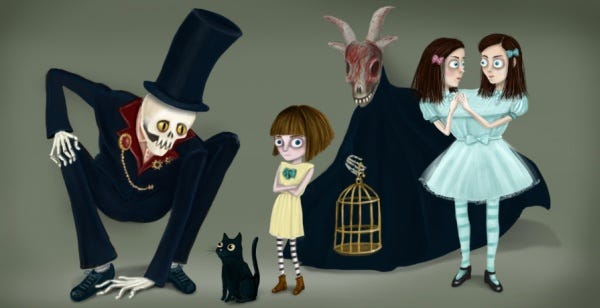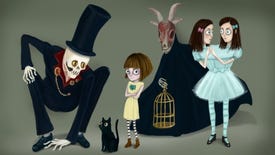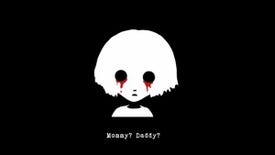Fran Bow Is A Worthy Heir To Wonderland
"Morbidly curiouser and curiouser!" cried Fran
Fran Bow [official site] made me smile more than any other game I've played this year.
That might come as a surprise if all you've seen of the game is a couple of screenshots featuring gore and dead kids. Fran Bow opens with a gory murder scene and then traps its young protagonist in a creepy institution for (criminally?) insane children. But that initial setting and the dark tone are just a small slice of a story that spans worlds and perfectly captures the beautiful, delightful nonsense of Alice's Adventures, an inspiration that is imprinted on the game.
Extending Alice's curiosity to pitch black MORBID curiosity leads to an intelligent, melancholy and eventually hopeful journey toward an acceptance and understanding of death.
Note: there are comments about theme and plot that you may consider to be spoilers - nothing specific is mentioned, except in one minor case that is flagged up later in the article.
The art style won me over immediately. Not just imaginative but beautifully detailed, the early scenes are claustrophobic, dingy and dripping with gore. It's more like 1980s oddity Weird Dreams than anything in the retro adventure revival. Perspectives are foreshortened and confused so that even mundane objects seem weird, and that's before Fran swallows one of the pills from her infinite supply, allowing her to see the machinery of the world. That machinery is in the form of exposed muscle, bone and organs, as well as ethereal entities that may be spirit vampires or perhaps representations of emotional and mental collapse.
I had doubts about the game's treatment of mental illness and chemical treatment as a gateway to insight and terrible wonders, but a couple of hours into the game they were laid to bed. Fran Bow is about grief, and learning to process feelings and events. As the story develops, it swiftly moves away from the use of illness as a vehicle for shocks and scares, although if you only played the demo you might think that's the game's entire raison d'etre.
That opening is essential. As Fran develops, her ability to confront horrors with a sense of polite wonder rather than fleeing from them comes to define her. She is able to face down nightmarish creatures in the same way that Alice dismisses The Red Queen through the Looking Glass. Fran's 'enemy' isn't her own mind – it is death, and specifically the death of her parents, and it is death that she considers to be “the cause of all the mischief”.
Carroll saw The Red Queen as “the concentrated essence of all governesses” rather than an “aimless fury” like Wonderland's Queen of Hearts. Death, in Fran Bow, is a thing of tooth, claws, bone and blood. Or at least that's how Fran sees it. She has a remarkable capacity to learn though and the Death at the game's beginning is not the same as the Death at the game's mid-point or end. I don't know if I've ever played a game that so clearly and convincingly shows a character's acquisition of knowledge and experience – here, not represented by growth of stats and numbers, but by dialogue, image and the text that makes up Fran's thoughts.
Where Carroll's work investigates Alice's attempts to assert and defy logic and lessons learned, Fran Bow is an investigation of a child's attempt to understand death. That both the character and the game refuse to flinch and cringe from the inevitable allows for all manner of playful and hopeful encounters. Fran comes to appreciate that what might seem monstrous or uncaring may simply be part of the natural order; she learns not only to accept but to make what initially seems mysterious or unbearable into a part of her own imaginative life.
Until now I've avoided spoiling any specific scenes or characters, outside vague suggestions and the material covered in the demo. I'm going to mention one minor character – or species perhaps – in some detail though because without spoiling anything major, it encapsulates everything that I love about the game. It's the Deadleeworm.
The confusion of language is a recurring theme, as is the confusion of intent and appearance. The Deadleeworm isn't the corpse that's hanging there, the voice is coming from inside the guts – the Deadleeworm is a tiny maggoty-thing that is dressed, adorably, like a miniature Grim Reaper. It comes when we die, to feast on us. It is Death. And it is friendly, kind, compassionate and helpful. After meeting the worm, Fran will occasionally think about it, especially when a particularly grotesque corpse blocks her path or requires some close scrutiny. Through the encounter and the conversation, she gains an understanding of the necessity of death and decay, and the Deadleeworm is a coping mechanism directed at the horror of the body's eventual failure.
That, for me, is the game in a nutshell. I'm only at 'misfortune' rather than 'carelessness' on Lady Bracknells's Parental Loss Chart but I could have done with some of Fran's lessons six years ago when I was trying to wrap my head around the idea that somebody who has been there since the beginning can be gone. Forever. For good, for bad and for the rest. I'll be glad to have those lessons with me next time around, hopefully many years from now.
There's an impressive and inspiring resilience behind Fran's barely faltering politeness and occasionally impish inquisitiveness. She is always willing to forgive if somebody gives her a reason to but when she's wronged, her indignation would make a Lord or Lady wither in humility and disgrace. Even Death itself shrinks before her at times but she cannot change it or prevent it - can only admonish it for its lack of care and affection. The Deadleeworm is that care and affection made real.
Her tale has unsatisfactory loose ends and a central mystery that I felt was a distraction at times, but Natalia Figueroa and Isak Martinsson have used the trappings of psychological horror and the lasting terrors of childhood trauma to create a game that sits alongside Wonderland and Oz – imaginative, strange, unsettling, intelligent and charged with a rare and beautiful sense of hope.
I've always found A Boat Beneath A Sunny Sky, the poem that closes Through the Looking Glass, to be intensely melancholy. Even if it were not laden with the acrostic dedication that leads to a relationship now heavy with speculation, the poem seems to me like reflection packed with regret. Look, here it is:
A boat beneath a sunny sky,
Lingering onward dreamily
In an evening of July —
Children three that nestle near,
Eager eye and willing ear,
Pleased a simple tale to hear —
Long had paled that sunny sky:
Echoes fade and memories die.
Autumn frosts have slain July.
Still she haunts me, phantomwise,
Alice moving under skies
Never seen by waking eyes.
Children yet, the tale to hear,
Eager eye and willing ear,
Lovingly shall nestle near.
In a Wonderland they lie,
Dreaming as the days go by,
Dreaming as the summers die:
Ever drifting down the stream —
Lingering in the golden gleam —
Life, what is it but a dream?
Chokes me up every time. I do not want to see Alice put away childish things and I'm still not sure if that is what she has been doing, in part, throughout her adventures. Do the experiences add to her self or do they take parts away to replace them?
Fran sees dead things, including images of her own body neatly separated into parcels or otherwise disfigured. Nothing is taken from her though – in learning to cope with her sorrow and fear, she allows both to grow rather than eliminating them. By accepting them, she nurtures them and makes them stronger. Fear, this horror game tells us, is often misdirected. If we can control it, we can apply it where it is needed and shine a light where it is not.

















